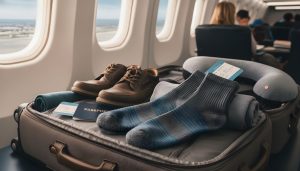
I’ve spent years trying to make long flights and road trips less tiring, but one thing that truly made a difference was finding the right support wear for my legs. After countless hours in cramped airplane seats and airport lounges, I learned that a simple pair of snug-fitting socks could change how I feel after a trip. Today, I’ll share what I’ve learned about choosing the best compression socks for travel—how they work, what to look for, and which features actually matter.
What You’ll Learn Here
- How compression technology supports healthy circulation during long journeys.
- What materials and pressure levels work best for frequent flyers?
- How to find your right fit (and why size matters more than style).
- When to wear them and how to care for them for lasting comfort.
- My personal insights from years of testing travel gear.
Why We Should Never Travel Without Supportive Legwear
I used to think those tight-fitting socks were only for athletes or medical use. But after my first 14-hour flight from Dubai to Toronto, my ankles felt like they’d doubled in size. That’s when I decided to try a pair designed for travelers. The difference was noticeable—I didn’t just avoid swelling; my legs actually felt energized even after landing.
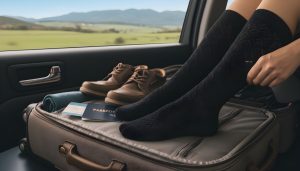
What the best compression socks for travel do is simple yet effective. They apply gentle, graduated pressure—snugger at the ankle and gradually lighter up the calf. This helps your veins push blood back toward the heart, reducing the risk of swelling, fatigue, and even clots during long periods of sitting.
Medical professionals often recommend mild to moderate pressure (about 15–20 mmHg) for travelers. It’s comfortable enough for everyday wear yet firm enough to promote circulation.
How Compression Works
Think of your veins as small tubes carrying blood upward against gravity. When you sit for hours, that flow slows down, and fluid collects in your lower legs. The light squeeze from travel socks gently nudges that blood upward again, keeping circulation steady.
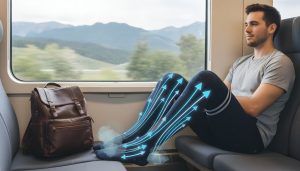
It’s not a miracle cure—just good physics and smart textile design. This is why doctors and seasoned travelers alike swear by them. They’re especially useful if you often deal with tired legs, mild swelling, or simply want to feel fresher after a long day on your feet.
What to Look For in Travel-Ready Legwear
Over the years, I’ve learned that not all supportive socks are made equal. Some feel too tight, while others barely make a difference. Here are the main things I always check before buying a new pair:
1. Material and Breathability
The right fabric determines whether your feet stay cool or turn into tiny saunas mid-flight.
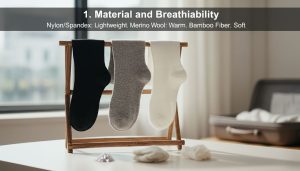
- Nylon and spandex blends: Lightweight, stretchy, and quick-drying—perfect for warmer climates.
- Merino wool: Naturally odor-resistant and thermoregulating. Ideal for cold flights or winter trips.
- Bamboo fiber: Ultra-soft and breathable, great for sensitive skin.
When I’m traveling in humid places, I always go for moisture-wicking blends. It makes all the difference after hours of wear.
2. Pressure Level (mmHg)
Support socks come in varying tightness levels measured in mmHg (millimeters of mercury).
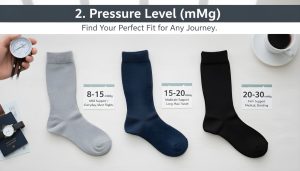
- Mild (8–15 mmHg)—great for everyday use or short flights.
- Moderate (15–20 mmHg)—ideal for long-haul travel.
- Firm (20–30 mmHg)—best for those with circulation issues or who stand all day.
I personally stick to moderate compression. It offers just enough support without feeling restrictive, even during overnight flights.
3. Fit and Comfort
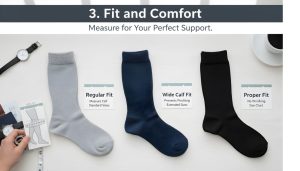
Fit is everything. If it’s too loose, you lose the benefit. Too tight, and you’ll regret wearing them. I always measure around the widest part of my calf and check the brand’s size chart before ordering the Best Compression Socks for Travel. If I’m between sizes, I usually go one size up for comfort.
For travelers with wider calves, brands now offer extended sizing, which helps prevent pinching and discomfort.
4. Length
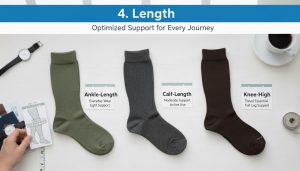
Most travel-specific pairs are knee-high since that length supports the lower leg fully. Ankle-length options exist, but they’re better for everyday wear rather than flights.
5. Durability
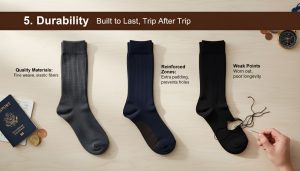
I’ve had pairs that lasted over a year and others that wore out after two trips. Look for reinforced heels and toes—those small details make them last longer and prevent holes.
When to Wear Them (And When Not To)
I wear mine before boarding the plane and don’t take them off until I’ve reached my hotel. It’s best to put them on before swelling starts—think prevention, not reaction.
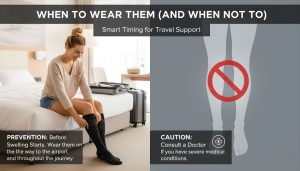
However, if you have a medical condition like severe varicose veins or circulation disorders, it’s smart to consult your doctor first. In most cases, mild or moderate levels are perfectly safe for healthy travelers.
How Specialists Tested and Compared Different Options
Through my work as an SEO expert and frequent traveler, I’ve tried more pairs than I can count. I tested each one based on comfort, breathability, ease of wearing, and how my legs felt after long hours of sitting.
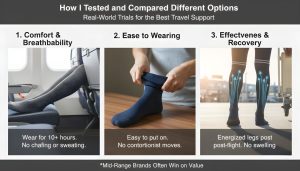
Interestingly, the most expensive pair isn’t always the best. Sometimes, mid-range options outperform the premium ones in comfort and practicality.
And let’s be honest—no one wants to struggle like a contortionist trying to pull socks up in a tiny airplane bathroom.
Expert Insight: Why Doctors Recommend Them
According to Dr. Hillary Brenner, a New York-based podiatrist, the graduated design is what makes them effective. The snug pressure at the ankle gradually decreases toward the knee, promoting better blood return and minimizing swelling.
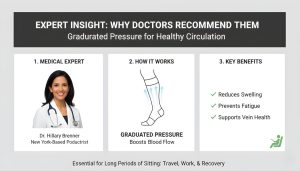
This is especially beneficial for people who spend long hours sitting—whether you’re flying, driving, or working at a desk. The goal isn’t just to prevent discomfort; it’s to support healthy circulation over time.
Practical Tips for First-Time Users
If you’ve never tried supportive legwear before, here’s my quick guide:
- Put them on in the morning when your legs are least swollen.
- Smooth out wrinkles as you pull them up—folds can cause discomfort.
- Wash them gently in cold water to maintain elasticity.
- Replace them every 4–6 months if worn frequently.
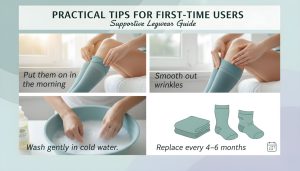
A little maintenance goes a long way. You’ll know it’s time for a new pair when they feel loose or lose their firmness.
Common Myths (And the Truth Behind Them)
Myth 1: They’re only for old people.
Nope. Frequent flyers, runners, and even office workers benefit from better circulation.
Myth 2: They’re uncomfortable.
Modern materials are soft, stretchy, and breathable. Some pairs even feel like regular athletic wear.
Myth 3: They’re unnecessary if you move around.
Even with in-flight stretches, long sitting hours still slow blood flow. These socks simply help nature along.
How to Choose the Right Pair of Best Compression Socks for Travel
I usually start by asking myself two questions:
- How long will I be sitting or standing during the trip?
- What’s the temperature where I’m going?

If I’m traveling somewhere warm, I’ll go with lightweight nylon blends. For colder places, wool is my go-to. I’ve even written more about essential travel accessories here for those looking to stay comfortable on the go.
For men looking for functional yet stylish travel gear, check out my travel accessories for men guide.
The Science Behind the Comfort
Studies published in The Journal of Vascular Surgery show that even mild compression can significantly reduce swelling and discomfort during flights longer than four hours. It’s not just about comfort—it’s about maintaining good leg health.
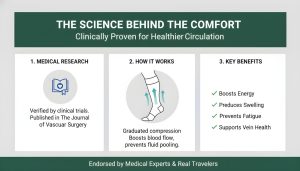
The science supports what most of us frequent flyers already know: better circulation means less fatigue and faster recovery.
Who Should Use Them Most
From my own experience, I’ve found that these socks make a huge difference for:
- Frequent flyers who spend hours seated.
- People with mild circulation issues or varicose veins.
- Anyone standing all day, like teachers, nurses, or retail workers.
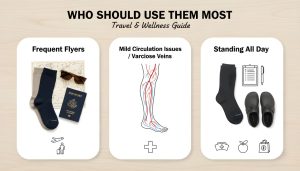
Even if you’re perfectly healthy, you’ll notice your legs feel lighter after long days of movement (or no movement at all).
A Few Words of Advice From Experience
Don’t buy your first pair the night before a trip. Test them during a regular day to see how they feel. That way, you can adjust the size or brand before relying on them mid-flight.
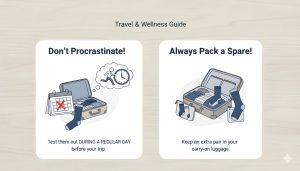
And please, bring an extra pair in your carry-on. There’s nothing worse than realizing you’ve left your favorite travel essential in checked luggage.
Final Thoughts
After years of flying across time zones, I can say this: compression Best Compression Socks for Travel isn’t just another travel trend. It’s a small investment in comfort and health that pays off every single time you travel.
They help you arrive fresher, move easier, and actually enjoy your trip instead of recovering from it. For anyone who spends long hours sitting—whether in planes, buses, or offices—these are worth every penny.
So the next time you’re planning your journey, don’t just pack your headphones and neck pillow. Add a pair of compression socks to your essentials—you’ll thank yourself later.